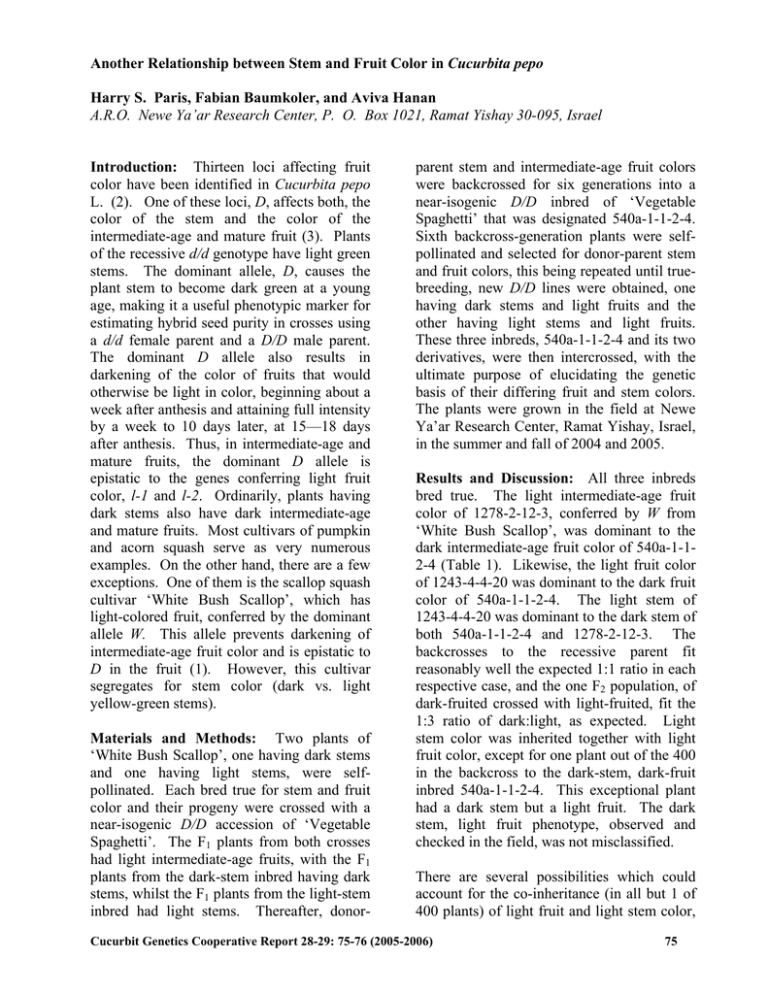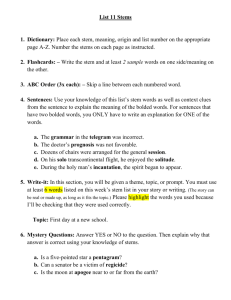Cucurbita pepo Harry S. Paris, Fabian Baumkoler, and Aviva Hanan Introduction:
advertisement

Another Relationship between Stem and Fruit Color in Cucurbita pepo Harry S. Paris, Fabian Baumkoler, and Aviva Hanan A.R.O. Newe Ya’ar Research Center, P. O. Box 1021, Ramat Yishay 30-095, Israel Introduction: Thirteen loci affecting fruit color have been identified in Cucurbita pepo L. (2). One of these loci, D, affects both, the color of the stem and the color of the intermediate-age and mature fruit (3). Plants of the recessive d/d genotype have light green stems. The dominant allele, D, causes the plant stem to become dark green at a young age, making it a useful phenotypic marker for estimating hybrid seed purity in crosses using a d/d female parent and a D/D male parent. The dominant D allele also results in darkening of the color of fruits that would otherwise be light in color, beginning about a week after anthesis and attaining full intensity by a week to 10 days later, at 15—18 days after anthesis. Thus, in intermediate-age and mature fruits, the dominant D allele is epistatic to the genes conferring light fruit color, l-1 and l-2. Ordinarily, plants having dark stems also have dark intermediate-age and mature fruits. Most cultivars of pumpkin and acorn squash serve as very numerous examples. On the other hand, there are a few exceptions. One of them is the scallop squash cultivar ‘White Bush Scallop’, which has light-colored fruit, conferred by the dominant allele W. This allele prevents darkening of intermediate-age fruit color and is epistatic to D in the fruit (1). However, this cultivar segregates for stem color (dark vs. light yellow-green stems). Materials and Methods: Two plants of ‘White Bush Scallop’, one having dark stems and one having light stems, were selfpollinated. Each bred true for stem and fruit color and their progeny were crossed with a near-isogenic D/D accession of ‘Vegetable Spaghetti’. The F1 plants from both crosses had light intermediate-age fruits, with the F1 plants from the dark-stem inbred having dark stems, whilst the F1 plants from the light-stem inbred had light stems. Thereafter, donor- parent stem and intermediate-age fruit colors were backcrossed for six generations into a near-isogenic D/D inbred of ‘Vegetable Spaghetti’ that was designated 540a-1-1-2-4. Sixth backcross-generation plants were selfpollinated and selected for donor-parent stem and fruit colors, this being repeated until truebreeding, new D/D lines were obtained, one having dark stems and light fruits and the other having light stems and light fruits. These three inbreds, 540a-1-1-2-4 and its two derivatives, were then intercrossed, with the ultimate purpose of elucidating the genetic basis of their differing fruit and stem colors. The plants were grown in the field at Newe Ya’ar Research Center, Ramat Yishay, Israel, in the summer and fall of 2004 and 2005. Results and Discussion: All three inbreds bred true. The light intermediate-age fruit color of 1278-2-12-3, conferred by W from ‘White Bush Scallop’, was dominant to the dark intermediate-age fruit color of 540a-1-12-4 (Table 1). Likewise, the light fruit color of 1243-4-4-20 was dominant to the dark fruit color of 540a-1-1-2-4. The light stem of 1243-4-4-20 was dominant to the dark stem of both 540a-1-1-2-4 and 1278-2-12-3. The backcrosses to the recessive parent fit reasonably well the expected 1:1 ratio in each respective case, and the one F2 population, of dark-fruited crossed with light-fruited, fit the 1:3 ratio of dark:light, as expected. Light stem color was inherited together with light fruit color, except for one plant out of the 400 in the backcross to the dark-stem, dark-fruit inbred 540a-1-1-2-4. This exceptional plant had a dark stem but a light fruit. The dark stem, light fruit phenotype, observed and checked in the field, was not misclassified. There are several possibilities which could account for the co-inheritance (in all but 1 of 400 plants) of light fruit and light stem color, Cucurbit Genetics Cooperative Report 28-29: 75-76 (2005-2006) 75 as exhibited by accession 1243-4-4-20. There may exist a gene for light stem color that is separate from but tightly linked to gene W. This could account for the one exceptional plant in the backcross but proof would require finding the opposite exception, that is, a plant having a light stem and a dark fruit. Another possibility is that there may be duplicate, tightly linked genes for light fruit color, one of which, W, affects fruit color only and another, heretofore unidentified, which affects both fruit and stem color. To test this, a much larger population of the testcross (Table 1) is needed. A third possibility is that the W locus is a tri-allelic series, with a heretofore unidentified allele affecting both stem and fruit color being the top dominant of the three; the one exceptional plant would then have to be attributed to an error in pollination or seed harvest. Or, it could be attributable to a mutation of the top-dominant allele. The yellow-green hue of the light-stem plants of this material is not suggestive of vitality. Literature Cited: 1. Paris, H.S. 1995. The dominant Wf (white flesh) allele is necessary for expression of “white” mature fruit color in Cucurbita pepo, in G. Lester and J. Dunlap (eds.), Cucurbitaceae ’94. Gateway, Edinburg, Texas, pp. 219–220. 2. Paris, H.S. and R.N. Brown. 2005. The genes of pumpkin and squash. HortScience 40:1620–1630. 3. Paris, H.S. and H. Nerson. 1986. Genes for intense pigmentation of squash. J. Hered. 77:403–409. Table 1. Results of crossing among near-isogenic accessions differing in color of stem and intermediate-age (15-18 days past anthesis) fruit. Number of plants Dark stem, Dark stem, Light stem, Expected χ2 P Dark fruit Light fruit Light fruit ratio 26 0 0 0 24 0 0 21 0 18 10 0 1:1 2.286 0.13 Accession P1, 540a-1-1-2-4 P2, 1278-2-12-3 F1, P1 × P2 + P2 × P1 BC1, (P2 × P1) × P1 Total 26 24 21 28 P3, 1243-4-4-20 F1, P1 × P3 + P3 × P1 F2, (P1 × P3) ⊗ BC1, P1 × (P1 × P3) BC1, (P1 × P3) × P1 BC1, Total 9 20 86 167 233 400 0 0 21 93 120 213 0 0 0 0 1 1 9 20 65 74 112 186 1:3 1:1 1:1 1:1 0.016 2.162 0.348 1.960 F1, P2 × P3 + P3 × P2 Test, P1 × (P3 × P2) 16 80 0 0 0 38 16 42 1:1 0.200 0.64 76 0.90 0.14 0.55 0.16 Cucurbit Genetics Cooperative Report 28-29: 75-76 (2005-2006)





